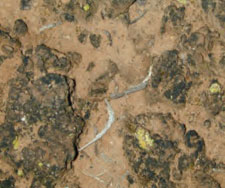What are biological soil crusts?
The development of environmental markets has focused agriculture’s thoughts back on the level of carbon in soil and raises questions about how soils can be better managed to store more carbon.
Most soil carbon is stored in the organic matter, so the higher the organic matter, the higher the soil cBdsdfarbon. More carbon and organic matter in a soil means improved fertility and better water-holding capacity.
Biological soil crusts are important structures that contribute to soil fertility and protect the soil surface from erosion and evaporation.
Appearance
Biological crusts consist of lichens, bryophytes, algae, microfungi, cyanobacteria and bacteria, growing on or up to 4mm below the soil surface. They are found globally in arid and semiarid environments and are common in Australia.
When wet, biological soil crusts appear as dark, slimy substances, changing to a thin, cracking film when dry. The colours of crusts will vary depending on the dominant organism in the crust.

The role of soil crusts in the environment
Some functions of biological soil crusts include:
- assisting in stabilising the soil, limiting erosion, and reducing runoff during storm events
- increasing the infiltration and storage of rainwater
- fixing atmospheric nitrogen
- contributing to the nutrients available for plant growth and health
- helping in soil plant–water relations
- assisting seedlings in germinating
- providing forage for insects.
The cyanobacteria, a component of these soil crusts, are photosynthetic.
Research has proposed that 25% of the earth’s carbon may be held by cyanobacteria in soil crusts and rock biofilms. Furthermore, research overseas has shown that cyanobacteria can fix between 0.02kg/ha/yr of nitrogen to as high as 100kg/ha/yr during optimal moisture and temperature conditions. At the higher level, the contribution of the cyanobacteria is the same as applying 10 x 20kg bags of urea to one hectare of pasture. In addition, other research is indicating that these biological organisms can secrete compounds that increase the bio-availability of phosphorus which, apart from nitrogen, can be one of our most limiting soil nutrients.
Biological soil crusts have an important and integral role to play in ensuring our soil biology is working. Research work in western New South Wales has shown that the crusts are susceptible to damage by continuous heavy stocking. A study at Cobar found that once the soil crust was damaged and broken up by heavy stocking rates, nutrient leaching in the sandy soils increased and soil moisture was lost. This contributed to a rundown in the productivity of the pasture.
It is worth keeping an eye out for these biological crusts on your soil surface. They might look insignificant but they could be playing a key role in keeping your soils productive and ecosystems in working order.
More information
Boosting natural regeneration of the nitrogen capital in grazing lands (project) →